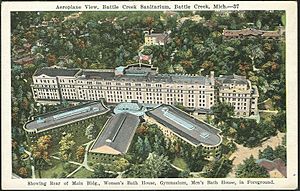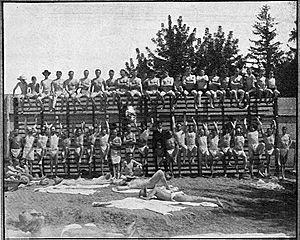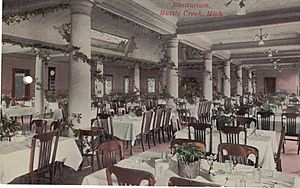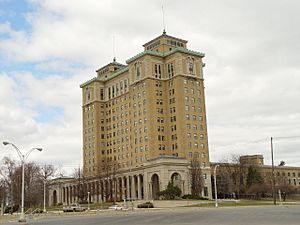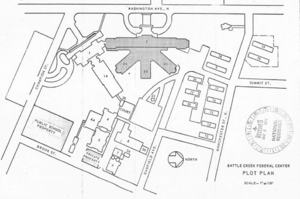Battle Creek Sanitarium facts for kids
|
Battle Creek Sanitarium
|
|
| Location | 74 N. Washington St. Battle Creek, Michigan |
|---|---|
| Built | 1903 |
| Architect | Frank Mills Andrews, M.J. Morehouse |
| Architectural style | Renaissance |
| NRHP reference No. | 74000980 (original) 11001060 (increase) |
Quick facts for kids Significant dates |
|
| Added to NRHP | July 30, 1974 |
| Boundary increase | January 27, 2012 |
The Battle Creek Sanitarium was a very famous health resort located in Battle Creek, Michigan, United States. It opened in 1866, based on health ideas from the Seventh-day Adventist Church. From 1876 to 1943, it was run by Dr. John Harvey Kellogg.
People often called it "the San." Under Dr. Kellogg's leadership, it became one of the top places in the U.S. for health and wellness. After a big fire in 1902, the Sanitarium was rebuilt and made even bigger. At its busiest, this huge health complex had over 30 buildings spread across 30 acres. It could host almost 1,300 guests. It included a hospital with research labs, a nursing school, and even a food company.
In 1928, a new 14-story section called "the Towers" was added to the main building. However, the Great Depression in the 1930s made it hard for the Sanitarium to stay open. It had to sell parts of its property. In 1942, the U.S. Army bought the main building and turned it into the Percy Jones Army Hospital. The Sanitarium then moved to a different building. The hospital closed in the 1950s. Today, the main building is known as the Hart–Dole–Inouye Federal Center.
In 1957, the Seventh-day Adventist Church took over the struggling Sanitarium. They ran it under a new name until 1993, when it was sold.
Contents
History of the Battle Creek Sanitarium
How the Sanitarium Started
In May 1866, Ellen G. White suggested creating a health center. This center would follow the new health ideas of the Seventh-day Adventist Church. Church leaders, including Ellen's husband James S. White, agreed. Construction began on the Western Health Reform Institute. This institute later became the Battle Creek Sanitarium.
It opened on September 5, 1866, and started taking patients. Dr. Horatio S. Lay was its first leader. In 1876, Dr. John Harvey Kellogg became the medical superintendent. His brother, W. K. Kellogg, worked as the bookkeeper. Dr. John H. Kellogg explained that they changed the word "sanatorium" to "sanitarium." A sanatorium was a health resort for sick soldiers. By changing two letters, they created a new word in English. Dr. Kellogg said the number of patients grew from 106 in 1866 to 7,006 in 1906.
Building and Growth
In 1878, a new wooden building called "Old Main" was built. It was updated in 1884 and 1891. The Old Main building burned down in 1902. It was then rebuilt with stone, making it 5 stories tall and much larger.
In 1928, the Battle Creek Sanitarium expanded even more. They added a 14-story high-rise with 265 guest rooms. This new section was called "the Towers." It faced Champion Street.
Changes and Closure
The institution faced financial trouble in 1933. In 1942, the U.S. Army bought the main building. They turned it into the Percy Jones General Hospital. This hospital closed in 1953. A year later, it became the Battle Creek Federal Center. The Battle Creek Sanitarium, still owned by the Seventh-day Adventists, continued as a mental health facility into the 1970s. It closed its doors by the end of that decade. In 1986, some parts of the main building, like the solarium and swimming pool, were torn down. The Sanitarium officially ended its operations in 1993.
The Sanitarium System: How it Worked
Guests, Staff, and Buildings
The Battle Creek Sanitarium had many guests and a large staff. Dr. Kellogg said that they always had at least 800 employees. During busy times, this number could go over 1,000. The staff included doctors, nurses, and other helpers. There were 30 doctors working there.
The main buildings included four large structures. The most important was the central building. It had rooms for about 400 guests. It also had treatment rooms that could serve over 1,000 patients.
The Sanitarium became a popular place for both famous and everyday Americans. Well-known people like Mary Todd Lincoln and Sojourner Truth visited. Their visits helped make health and wellness popular among everyone. The Battle Creek Sanitarium was known worldwide. It became the place where rich and famous people went to get healthy. They would listen to health talks and learn about healthy living.
Therapeutic System: Treatments Offered
At the Sanitarium, Dr. Kellogg tried different treatments for his patients. These included changes to their diet and regular enemas. He suggested a vegetarian diet that was low in fat and protein. This diet focused on whole grains, foods with lots of fiber, and especially nuts. Dr. Kellogg also believed in getting fresh air every day, exercising, and being very clean. Many of his ideas were later published in his book The Road to Wellness.
Kellogg described the Sanitarium system as a complete health method. It included hydrotherapy (water treatments), phototherapy (light treatments), thermotherapy (heat treatments), electrotherapy (electricity treatments), mechanotherapy (machine-assisted exercises), dietetics (special diets), physical culture (exercise), cold-air cures, and health training. They also checked how well the body's systems were working. This included checking the blood, heart, lungs, liver, kidneys, stomach, intestines, brain, nerves, and muscles.
Hydrotherapy: Water Treatments
Hydrotherapy was used a lot. There were two three-story buildings, one for men and one for women, just for water treatments. Each building had a basement for special bowel treatments and classrooms. Both buildings were connected to the main building and the large gymnasium. Kellogg said that hydrotherapy was a key part of modern health care. He believed the Battle Creek Sanitarium was a leader in scientific hydrotherapy in America.
Kellogg's use of water treatments was more advanced than earlier methods. Early 19th-century methods mostly used cold water. The Battle Creek system used both hot and cold water. They combined water treatments with other therapies. Methods included showers, sitz baths, cold mitten rubs, salt glows, and different types of full baths. Kellogg believed that using hot and cold water would have strong effects on the body, like making blood vessels expand and shrink.
Light and Electricity Treatments
This department used both sunlight and electric light. Electric light was mainly used in winter. Light therapy was very important at Battle Creek. The first electric light bath was built there. Kellogg also used electricity, but he said it wasn't as magical as some people claimed. Still, he found it useful when combined with water and heat treatments.
Physical Training: Exercise and Movement
Physical exercise was a big part of the Battle Creek system. It helped improve muscles, posture, breathing, and blood flow. Exercises included posture training, calisthenics (bodyweight exercises), gymnastics, and swimming. They also used passive methods like machines and mechanical massage.
Open-Air and Cold-Air Methods
Kellogg believed that being exposed to the sun and fresh air was very important for health. Battle Creek had a large outdoor gymnasium. Patients would exercise and then jump into a cool, refreshing swimming pool. Patients were also encouraged to sleep outdoors. Many outdoor activities were available, like chopping wood, playing basketball, walking, and swimming lessons. They also offered skating, tobogganing, and skiing. Kellogg said that patients got all the benefits of a beach trip or camping. They were also protected from doing too much, with doctors guiding them and special diets.
Dietetics: Healthy Eating
The Battle Creek Sanitarium used the best knowledge of the time to provide healthy food. They made sure the food met each person's needs. Food was carefully prepared to be tasty and appealing. The diet lists included many special dishes and food preparations. Each food was studied for its nutrition and health benefits. All the famous "Sanitarium health foods" were first created for use at the Sanitarium.
The Sanitarium's Decline
After the Wall Street Crash of 1929, fewer wealthy patients could afford to come to the Sanitarium. Money became very tight for "the San." In 1933, the complex was put under a special financial management plan. The Sanitarium stayed open until after World War II began.
The U.S. Army needed a hospital. They paid $2,341,000 for the Sanitarium complex and turned it into Percy Jones Army Hospital. Later, the complex became a federal center. Today, it is called the Hart–Dole–Inouye Federal Center.
National Historic Recognition
The Battle Creek Sanitarium was added to the National Register of Historic Places in 1976. This first listing included only the main building. It is a long, six-story building in the Italian Renaissance Revival style. It sits next to North Washington Avenue. In 2012, the listing was expanded. It now includes the 1928 tower, other buildings built before 1953, and the entire site.








